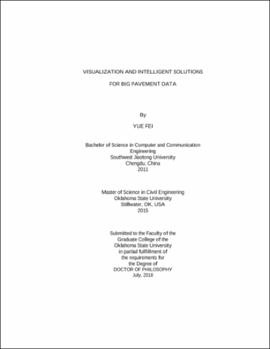| dc.contributor.advisor | Wang, Kelvin C. P. | |
| dc.contributor.author | Fei, Yue | |
| dc.date.accessioned | 2021-08-30T15:33:43Z | |
| dc.date.available | 2021-08-30T15:33:43Z | |
| dc.date.issued | 2018-07 | |
| dc.identifier.uri | https://hdl.handle.net/11244/330747 | |
| dc.description.abstract | Pavement visualization and crack detection are two important components supporting modern pavement condition survey. In this dissertation, two major goals are accomplished based on implementable algorithms. 1) The long-distance pavement 3D visualization is developed based on an effective Level-of-Details (LOD) algorithm named "Geometry Clipmap". The Geometry Clipmap is able to render large-scale 3D scene by caching pavement height data in a set of nested grids. During 3D rendering process based on Geometry Clipmap, the data size uploaded to video memory is reduced significantly, while the detailed high-resolution pavement surface data are still retained for further detailed inspection. As a consequence, Geometry Clipmap provides long-distance pavement display with excellent visual continuity and stable frames per second (FPS). In addition, the size of large-area surface distresses can be directly measured under long-distance pavement 3D environment. This is the first study that applies LOD algorithm to long-distance 3D pavement visualization and large-scale distress measurement. 2) The pixel-level automated crack detection is achieved through the modifications of Cell-based Convolutional Neural Network (CNN) on 3D pavement surface. CNN is a deep learning algorithm that targets at recognizing Cell-based imaging objects. Based on combination of specific pre-process layers and new gradient computational strategy, the network for pixel-level detection is developed in the study for effective feature learning. In addition, consecutive convolutional layers and a new activation unit are introduced to improve the detection performance at fine and shallow cracks. Furthermore, GPU parallel computing techniques are utilized to speed up the proposed pixel-level detection network. As a result, the CNN based pixel-level crack detection outperforms traditional imaging algorithms in terms of F-Measure. Lastly, the highly-efficient Deep-Learning network for speedy processing fits well for big pavement datasets processing. | |
| dc.format | application/pdf | |
| dc.language | en_US | |
| dc.rights | Copyright is held by the author who has granted the Oklahoma State University Library the non-exclusive right to share this material in its institutional repository. Contact Digital Library Services at lib-dls@okstate.edu or 405-744-9161 for the permission policy on the use, reproduction or distribution of this material. | |
| dc.title | Visualization and intelligent solutions for big pavement data | |
| dc.contributor.committeeMember | Li, Qiang (Joshua) | |
| dc.contributor.committeeMember | Cross, Stephen A. | |
| dc.contributor.committeeMember | Teague, Keith A. | |
| osu.filename | FEI_okstate_0664D_15886.pdf | |
| osu.accesstype | Open Access | |
| dc.type.genre | Dissertation | |
| dc.type.material | Text | |
| dc.subject.keywords | 3d visualization | |
| dc.subject.keywords | convolutional neural network | |
| dc.subject.keywords | crack detection | |
| dc.subject.keywords | deep learning | |
| dc.subject.keywords | geometry clipmap | |
| dc.subject.keywords | pavement condition survey | |
| thesis.degree.discipline | Civil Engineering | |
| thesis.degree.grantor | Oklahoma State University | |
